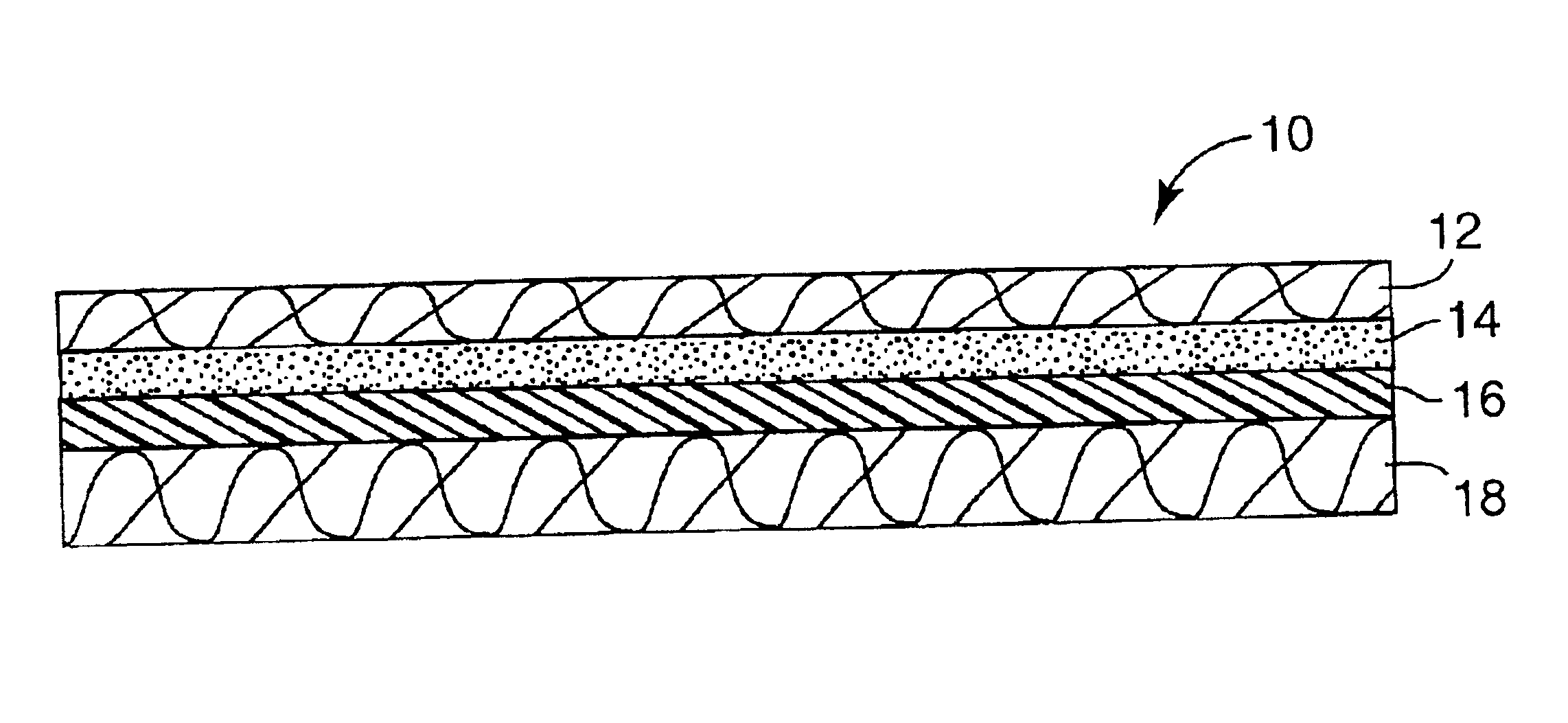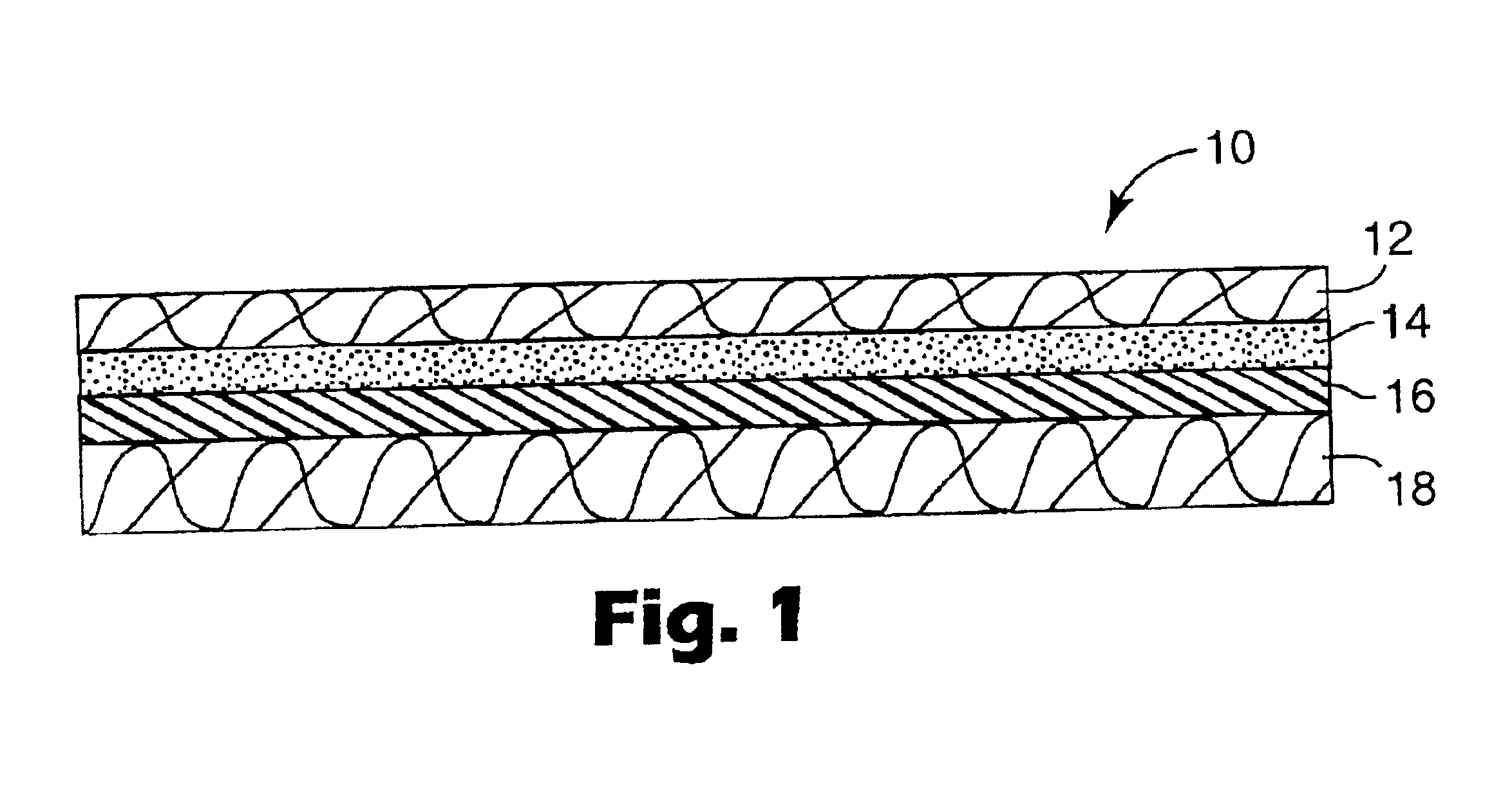K-type polarizer and preparation thereof
a polarizer and k-type technology, applied in the field of preparation of k-type polarizers, can solve the problems of unsuitability for many precision optical applications, and achieve the effects of reducing the loss of acid, improving moisture resistance, and reducing the risk of acid exposur
- Summary
- Abstract
- Description
- Claims
- Application Information
AI Technical Summary
Benefits of technology
Problems solved by technology
Method used
Image
Examples
example 1
[0116]A poly(isooctyl acrylate-co-isobornyl acrylate) polymer was prepared by solution polymerization as described below. A mixture of isooctyl acrylate (IOA, 90 parts by weight), isobornyl acrylate (IBA, 10 parts by weight), benzil dimethyl ketal (0.2 parts by weight, available as ESACURE KB-1 from Sartomer, West Chester Pa.), and ethyl acetate (100 parts by weight, available from EM Science, Gibbstown, N.J.) was added to a reaction vessel, sparged with N2 for 15 minutes, and exposed to UV light (two Sylvania F40 / 350 BL fluorescent tubes, Danvers, Mass.) for 18 hours with agitation. This sample was diluted with 50 parts by weight ethyl acetate and used to prepare the following examples. A series of examples were made by mixing 10 parts by weight of the polymer described above with 0-0.4 parts by weight of cyanuric chloride and 0-1 parts by weight of 1-decanol.
[0117]Using an eight-path wet film applicator, each of the solutions were coated at a wet thickness of 0.508 mm onto a previ...
example 2
[0121]A poly(IOA-co-IBA) polymer was made as described in Example 1. By mixing 10 parts by weight of this polymer overnight with 0-0.4 parts by weight of cyanuric chloride and 0-1.05 parts by weight of 1-decanol, a series of examples was made. Sandwich constructions were made with these solutions as described in Example 1. They were then converted by placing them in an oven at 165 ° C. for 15 minutes. After exposure to heat, all the examples except Example 2A, exhibited the maroon color characteristic of the partial dehydration of PVA. Results are summarized in Table 2.
[0122]
TABLE 2Cyanuric Chloride1-DecanolExample(parts by weight)(parts by weight)Color 2A*00none2B0.020.057uneven lightred-brown2C0.0410.109uneven red-brown2D0.120.312uneven red-brown2E0.20.521uneven darkred-brown2F0.20uneven red-brown2G0.280.73uneven darkred-brown2H0.4011.049uneven darkred-brown*comparative example
In particular, examples 2E and 2F demonstrate that free alcohol is advantageous for generating acid in t...
example 3
[0123]A copolymer of isooctyl acrylate (IOA) and acrylamide was prepared by solution polymerization. A mixture was prepared of 95 parts by weight IOA, 5 parts by weight acrylamide (ACM), 0.4 parts by weight 2,2′-azobis(2-methylbutronitrile), 2 parts by weight 2-propanol (EM Science, Gibbstown, N.J.), and 150 parts by weight ethyl acetate (EM Science, Gibbstown, N.J.). This mixture was sparged with nitrogen gas for 15 minutes then heated at 65° C. for 24 hours with agitation. By mixing 10 parts by weight of the resulting polymer solution with 0.2 parts by weight of cyanuric chloride and 0.52 parts by weight of 1-decanol overnight a sample was made. This mixture turned white overnight. The sandwich construction was prepared and converted as described in Example 1. After heating the example turned to a maroon color characteristic of the partial dehydration of PVA.
PUM
| Property | Measurement | Unit |
|---|---|---|
| wt. % | aaaaa | aaaaa |
| glass transition temperature | aaaaa | aaaaa |
| temperature | aaaaa | aaaaa |
Abstract
Description
Claims
Application Information
 Login to View More
Login to View More - R&D
- Intellectual Property
- Life Sciences
- Materials
- Tech Scout
- Unparalleled Data Quality
- Higher Quality Content
- 60% Fewer Hallucinations
Browse by: Latest US Patents, China's latest patents, Technical Efficacy Thesaurus, Application Domain, Technology Topic, Popular Technical Reports.
© 2025 PatSnap. All rights reserved.Legal|Privacy policy|Modern Slavery Act Transparency Statement|Sitemap|About US| Contact US: help@patsnap.com



